What is Mastodon?
To understand Mastodon, you need to understand the following terms first:
1. Open-source: Mastodon is open-sourced — which means it’s not owned by any one company. Instead, it’s produced by volunteers. This is what keeps it free, transparent, and collaborative.
2. Decentralized: Mastodon doesn’t operate on a single server or entity. Instead, it’s made up of many interconnected servers (called “instances”), each owned and operated independently by an individual or a community.
3. Fediverse: The Fediverse combines the words “federated” and “universe.” It refers to the network of interconnected servers — like ActivityPub and OStatus — which use compatible protocols. These servers can talk to each other, like how you can use your Gmail account to email someone’s Hotmail account. Or imagine being able to follow someone’s Instagram account from your Twitter account because all of it’s in the same universe. Mastodon is a part of the Fediverse — meaning it can connect to more than another Mastodon.
Knowing all of this, here’s the definition of Mastodon: It’s an open-source, decentralized social media platform that’s part of the Fediverse. There’s no social media algorithm. No ads. No monetization. Mastodon is a place shaped by its community of users.
The History of Mastodon
While Mastodon became popular as a Twitter (now X) alternative when Elon Musk acquired it, it’s been around for quite a while. It was launched in 2016 by Eugene Rochko, a software developer from Germany. It’s a non-profit organization that’s built to support the public.
Eugene shared he got involved in the web space in high school because his online programmer friends were into Identi.ca. He hates switching between multiple apps and communicating with his friends via various apps, which is why he might’ve wanted to build a decentralized platform that’ll — in his words — “work forever.”
As of 2022, the CEO and co-founder is the only full-time employee and the rest of the team (five people) are contractors. Patreon donations are one of the primary ways Mastodon earns money. In the future, Mastodon might start a for-profit SaaS business to provide hosting for Mastodon for users who desire it.
Understanding Decentralization
Decentralization is what makes Mastodon unique compared to other social media sites. It means Mastodon doesn’t operate on a single server and isn’t owned by one entity. It’s instead made up of lots of interconnected servers called instances.
Decentralization is what sets Mastodon apart from other social media platforms. Since there’s no single point of control or authority, Mastodon prevents censorship and data monopolies. It’s more democratic. Mastodon also allows for greater privacy and customizations. After all, every server can have its own rules, moderation policies, and community norms.
Mastodon vs. Traditional Social Media
Mastodon is the most similar to Twitter (now X) if you compare it to other social media platforms. Like Twitter (now X), Mastodon is a microblogging platform. The tweets on Mastodon are called “toots” and retweeting is “boosting.” Comments on toots are called “replies.” Mastodon also has a 500-character limit.
But, unlike the major social media platforms, Mastodon is open-sourced and decentralized. There are no algorithms, ads, or monetization tactics. No single corporation owns Mastodon.
How Mastodon Works
Creating an Account
You can create an account on Mastodon by joining a server (called “instances”). One of the most popular instances is Mastodon.social. If you want to join using another server, you can check out Mastodon’s list containing servers from a variety of topics. Don’t worry — the server you choose isn’t set in stone. You can always transfer your profile to another server later.
The next step is to create an account on the Mastodon server of your choice. This process is similar to signing up on any social media platform. You have to choose a username, enter some basic details, and verify your email.
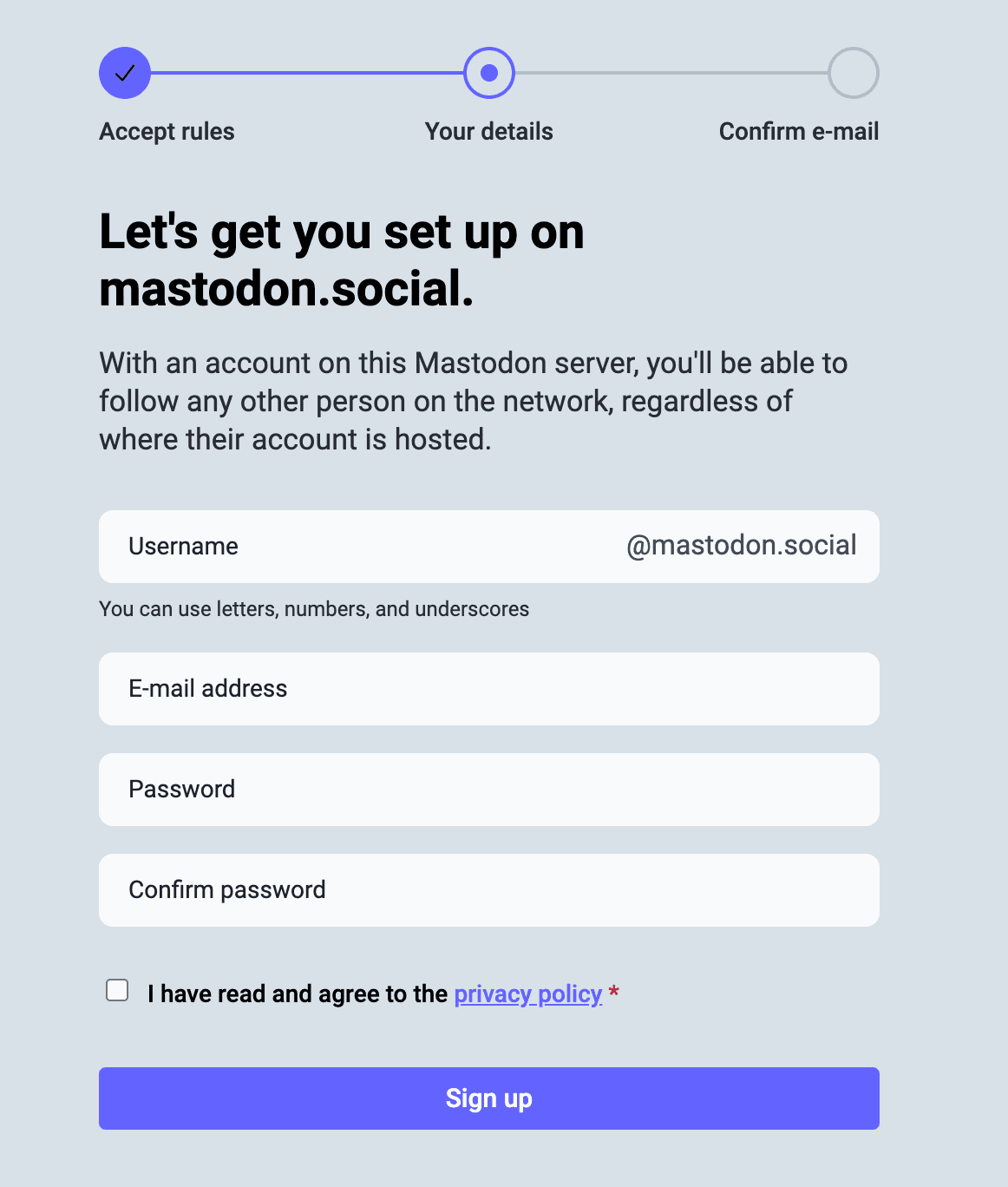
The last step is setting up your profile so people can find you. You can add a profile picture, start following other users on Mastodon to curate your home feed, add a bio, and post an introductory toot.
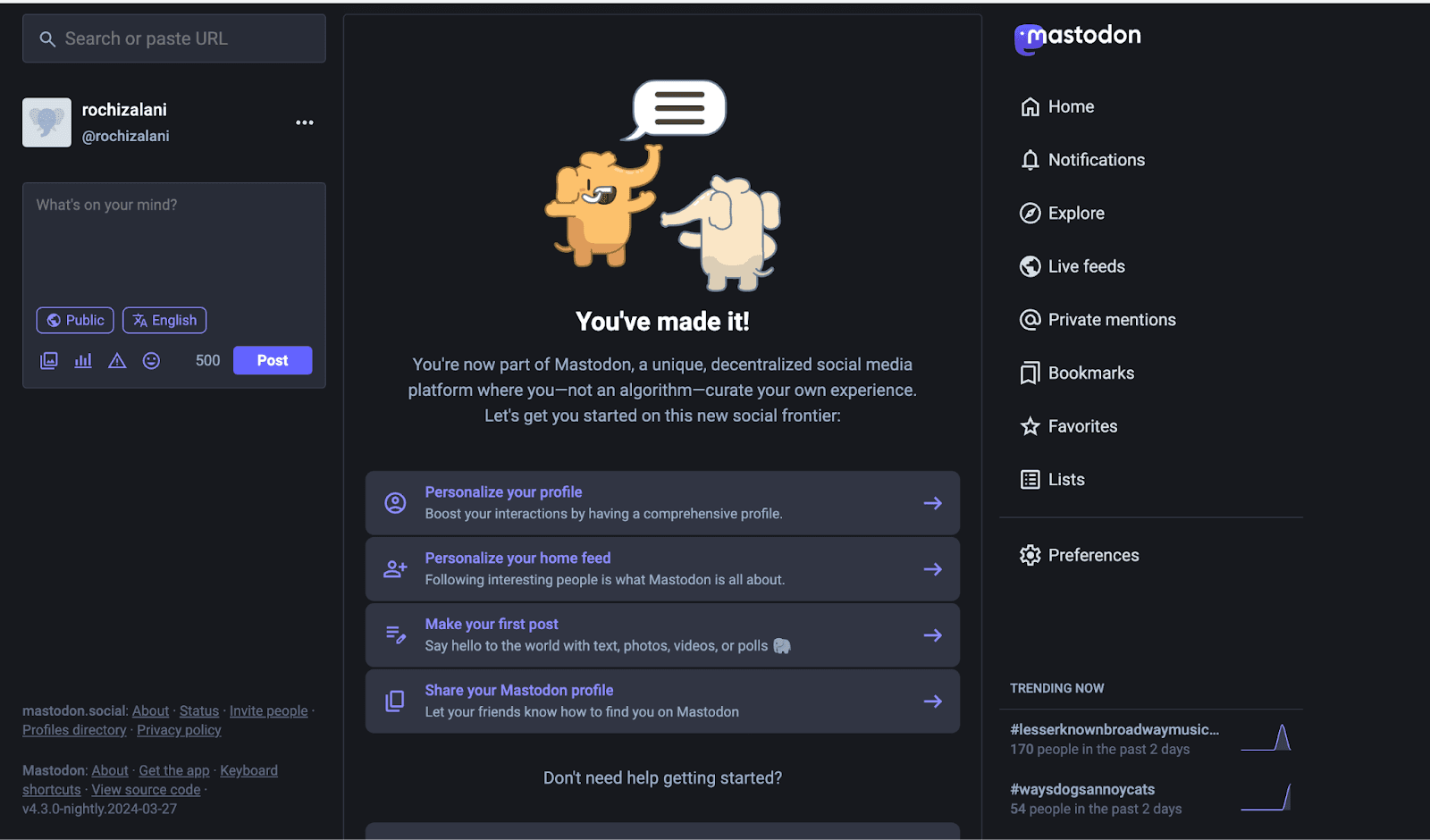
Understanding Instances
Instances are a synonym for individual servers in Mastodon. For example, there’s a techhub.social instance for passionate technologists who want to join a community of similar people. Each instance has its own ground rules, community guidelines, and moderation policies. Many instances also require moderators or creators of the server to approve your joining request.
But that doesn’t mean users from one instance can’t communicate with Mastodon users from another instance. Communication is completely decentralized. An instance just dictates the theme of your Mastodon feed.
The Fediverse and Interoperability
The Fediverse is a network of interconnected servers that use open-sourced code to connect users to each other. Mastodon is a part of the Fediverse, along with several other decentralized social networking platforms. This capability of Mastodon to communicate with other servers is called Interoperability.
The whole thing is better explained with an example: Let’s say there was a single place on the internet where you could like someone’s Instagram post, comment on their Twitter (now X) post, and have a discussion like you would on Reddit. All of the content on social media platforms would be part of a broader network. This is what Fediverse does, and it allows Mastodon to shine as the “one place for everything.”
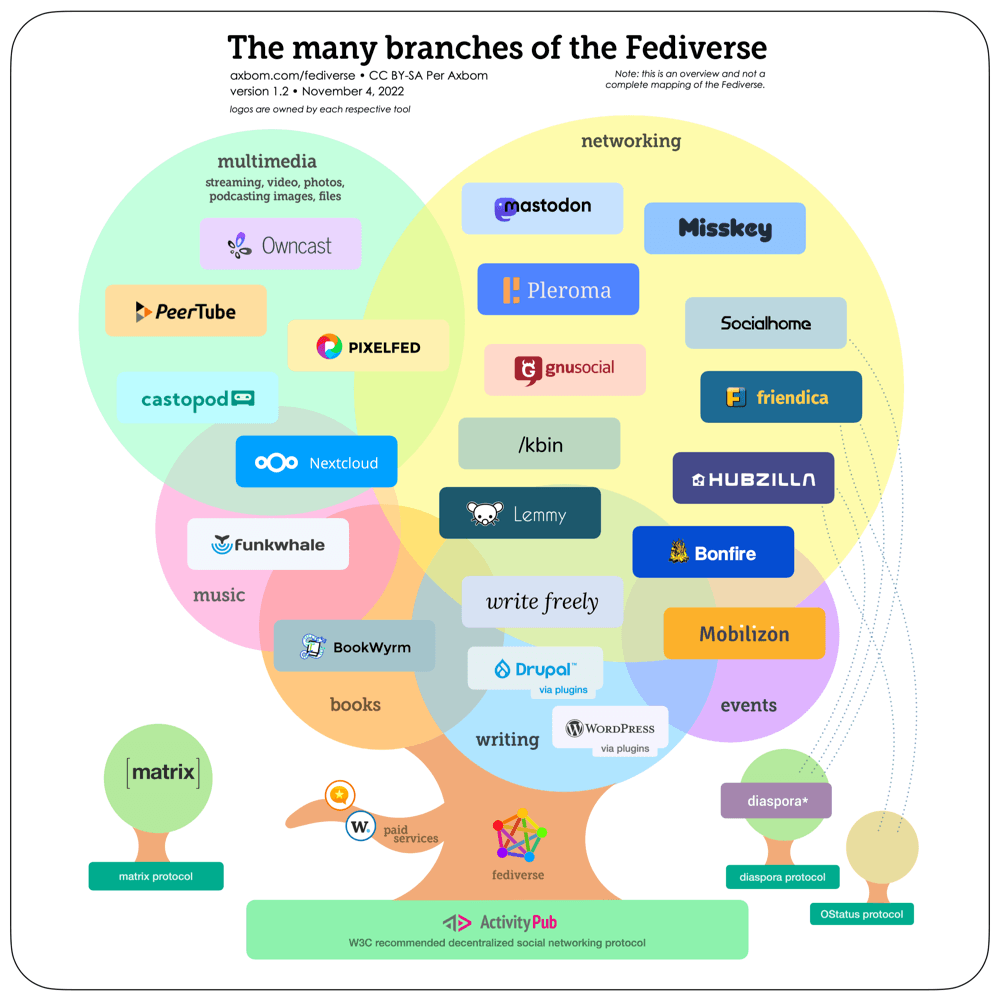
Features and Interface
Here are five of Mastodon’s key features:
1. You dictate your home feed: Algorithms aren’t present in Mastodon. Your home feed is a combination of the people and the hashtags you follow. You see toots in chronological order in which they were posted.
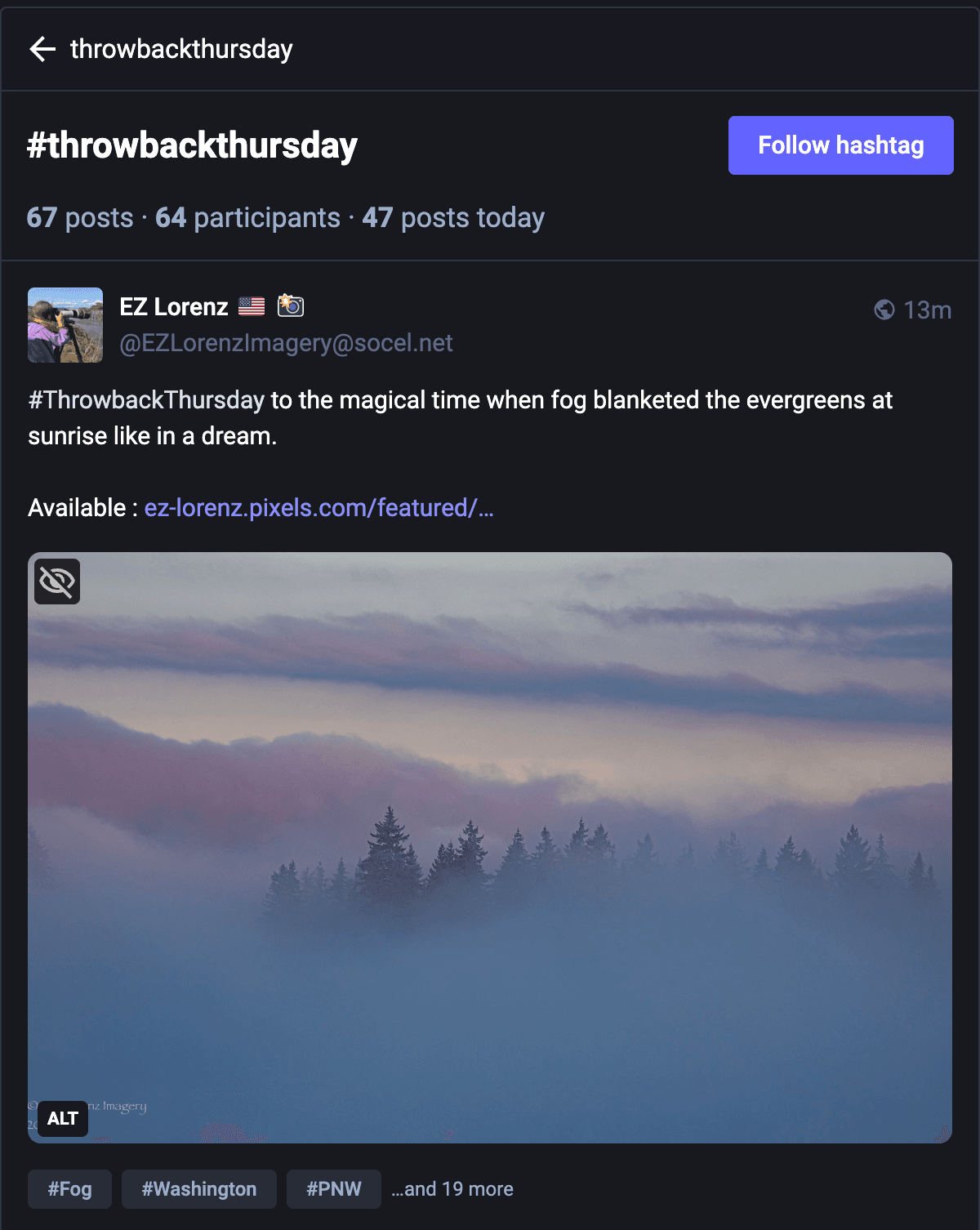
2. Content warnings: You can add a content warning to your post before posting toots that might be triggering for other users. Someone viewing your post can decide whether or not they want to see the full toot.

3. Filter content: In Mastodon settings, you can choose to filter certain parts of your interface — like not seeing posts about a specific topic on your public timeline. You can do this by adding keywords you don’t want to see and where you don’t want to see them.
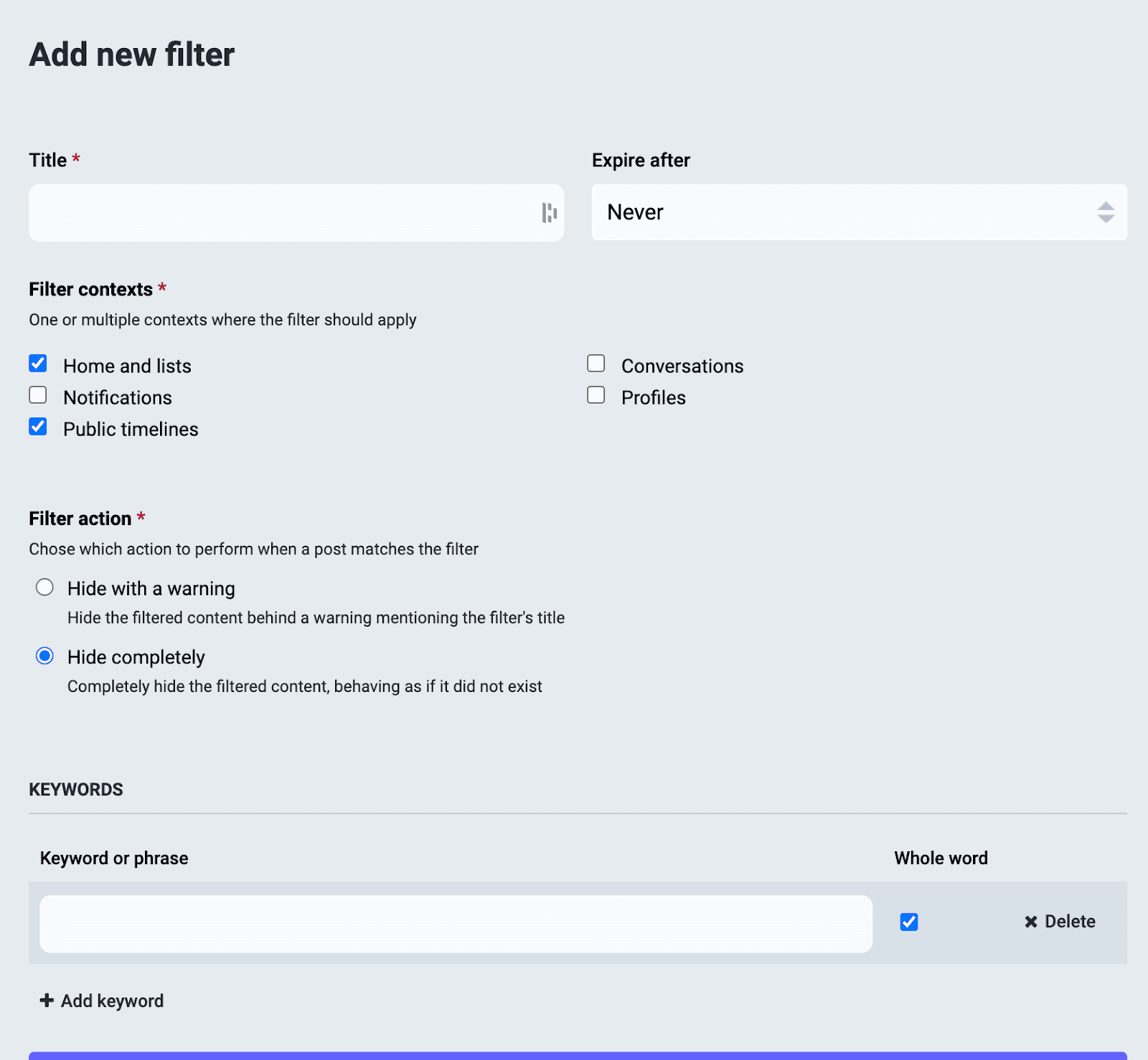
4. Bookmarks, favorites, and lists: You can bookmark and favorite toots in your feed and refer to them later. Like on Twitter (now X), you can also create a public or private list to organize the accounts you follow into specific groups.
5. Edit posts: Mastodon allows users to edit their posts after they go live at no cost.
Apart from the above standout features, Mastodon also has all the basic social media site features like muting & blocking users, pinning a toot, and filtering notifications.
Marketing on Mastodon
Is Mastodon Right for Your Brand?
Mastodon isn’t like every other social media platform. Here are three factors to consider if you’re thinking about using Mastodon for your social media marketing efforts:
1. Target audience: Mastodon’s audience is privacy-conscious, tech-savvy, and interested in niche topics. Its lingo, values, and user interface differ entirely from traditional social media sites. Consider whether your target audience is active on Mastodon before hopping on it.
2. Promotional activities: Mastodon is all about people and community building. Your social media calendar for Mastodon can’t include a lot of salesy, promotional content. The right way to engage Mastodon users is to post authentic, engaging, and helpful content. The lack of the algorithm also means you’ll have to communicate with users from various servers to build a genuine connection with them. Only sign up for Mastodon if you have the headspace and bandwidth to practice this on a regular basis.
3. Learning curve: Mastodon is like Twitter (now X) but still has its own rules and language. Learning how to engage on the platform, grow as a brand, and build a community will require some trial and error. Because it’s decentralized, it’s not as intuitive to get the hang of. Your social media team will need time, resources, and help to figure it out before you see any return on investment from Mastodon.
Building a Presence on Mastodon
Building a presence on Mastodon starts by choosing the right instance. If your target audience is already in a few niche instances, choose the most popular one to make your account. Also ensure that the server’s moderation policies suit your needs.
The next step is regularly posting relevant, engaging, and helpful content. Use hashtags to increase your reach and communicate with the right audience. Remember that Mastodon doesn’t have algorithms, so don’t evaluate the success of your posts by how many likes they get.
The last step is engaging meaningfully with your audience. Mastodon isn’t the place for overly promotional content. It’s about participating in conversations and building relationships. Post-and-ghost will not work well with Mastodon.
Engaging with the Community
How do you engage with your community on Mastodon? Once you join an instance, take some time to read through the users’ posts and get a feel for the server’s norms and culture.
After listening and learning, you can start contributing by engaging in meaningful conversations and posting helpful content. Focus on adding value to discussions rather than getting the most engagement. If you’re posting something sensitive, use content warnings.
And remember: Engaging and building a community takes time! Be patient and persistent with your efforts. Mastodon isn’t as straightforward as other social media platforms, and measuring its effectiveness for your small business is more complicated.
Content Strategies for Mastodon
Community should be at the center of your social media marketing content strategy for Mastodon. Focus on creating content that’d drive a conversation among your target audience. This can be:
1. Educational content: How-to guides, tips & tricks, and anything that helps your audience move the needle on their issues is well-suited for Mastodon.
2. Discussions: Polls, Q&A, and surveys assist in driving engagement because they encourage your audience to participate. Use the right hashtags to start conversations in your niche.
3. User-generated content: Use the above discussion type of posts to create user-generated content. This can be an advice someone shared, an opinion that needs more conversations, or a community spotlight.
Analytics and Measuring Success
Mastodon provides native analytics called MastoMetrics. You can see your top posts, number of followers, and total number of posts.
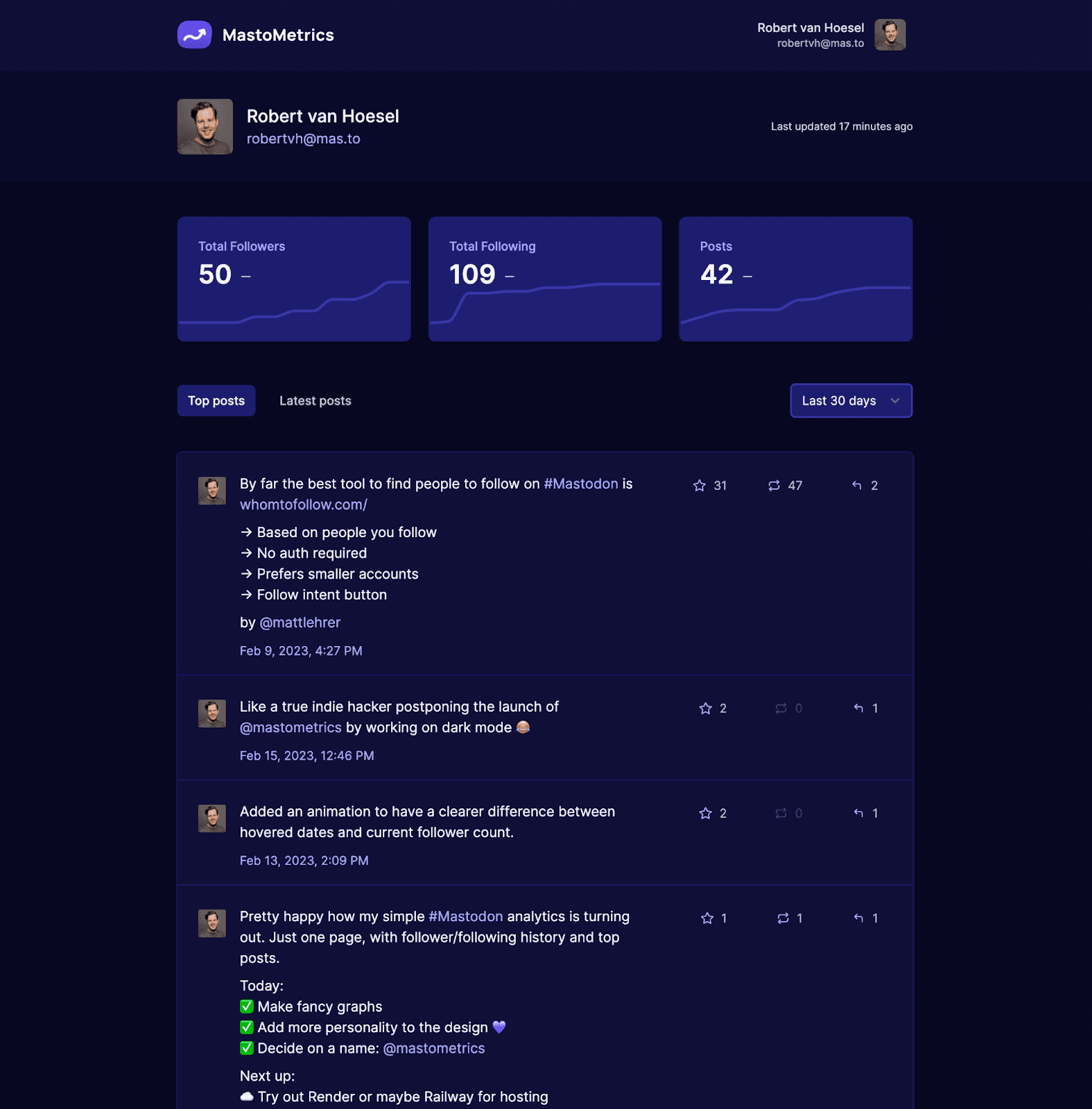
While it’s free, it’s certainly not enough. You can use third-party social media marketing tools that connect with Mastodon — like Buffer — to post consistently and get deeper analytics into how your posts are performing.
But most tools won’t be able to give you the engagement analytics because Mastodon is such a unique platform in terms of social media marketing for small businesses. It’s decentralized and the focus isn’t on selling as much as it’s on building a community.
Case Studies
Success Stories: Brands on Mastodon
Here are three brands that are acing the Mastodon game:
Internet Archive regularly shares user-generated content and other links its community might find helpful. It has over 47K followers on Mastodon and doesn’t shy away from the occasional promotion.
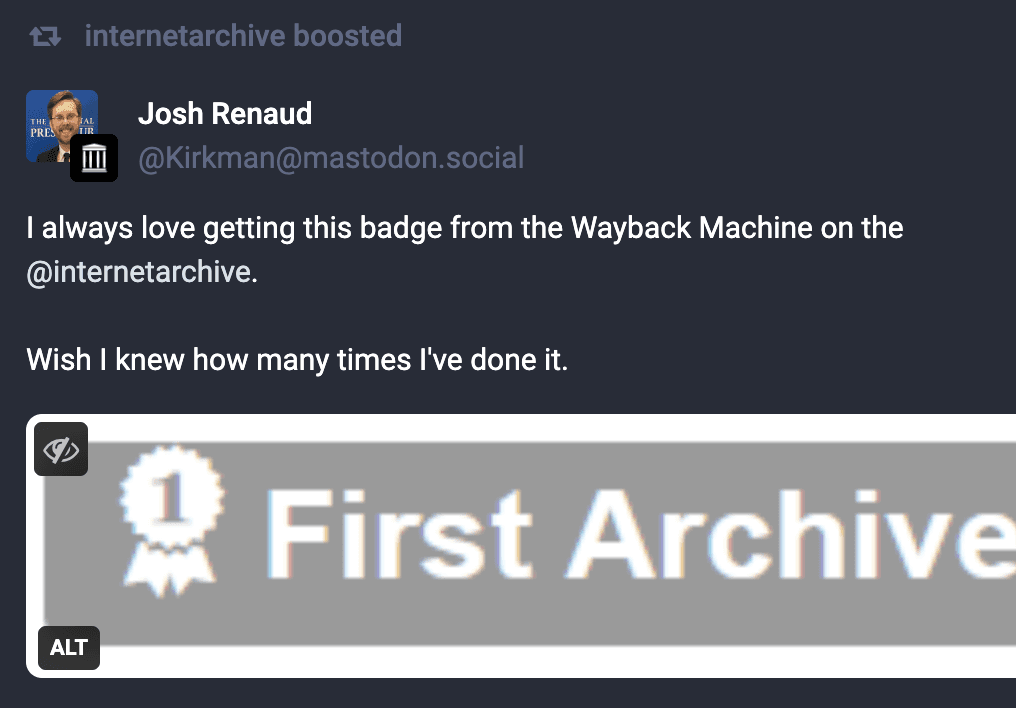
2. Electronic Frontier Foundation
Electronic Frontier Foundation shares updates about the blogs that recently went live on its website. It uses Mastodon to keep its audience informed and sprinkles a few promotional posts here and there. It has over 55K followers on the platform.
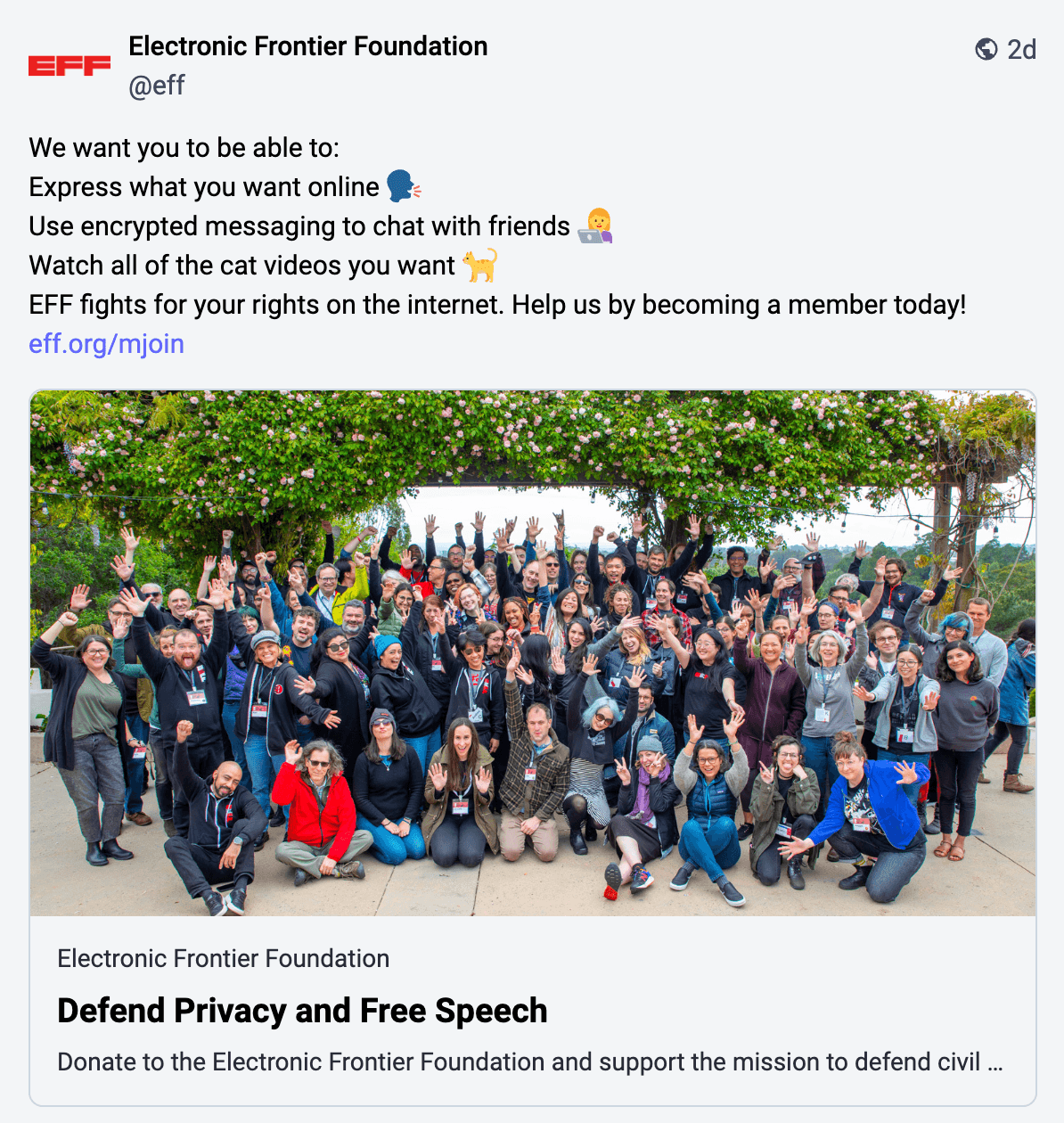
GNU Image Manipulation Program (GIMP) is a free image editor with over 9.5K followers on Mastodon. They primarily boost other users’ posts that would be relevant for their audience and also reply to relevant discussions.
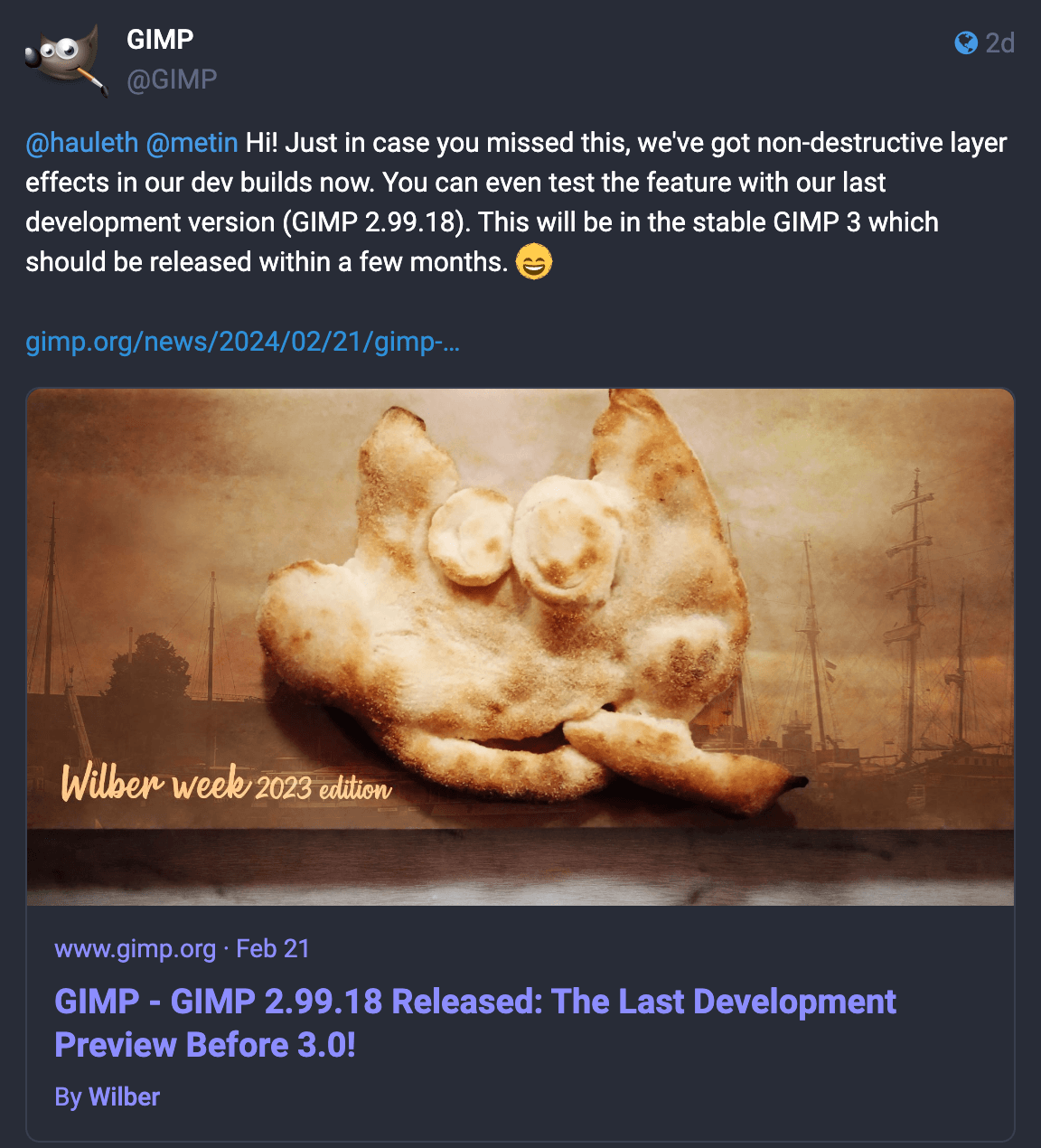
Learning from Challenges: What Didn’t Work
Here are three things that won’t work for brands on Mastodon:
1. Posting only promotional content: Mastodon doesn’t thrive in advertising. It’s a place for discussions and building your community. If you only post about your business and sell your products, engagement will be hard to come by. The audience on Mastodon isn’t there for ads.
2. Not interacting with your community: Even if you post only helpful content, Mastodon is a two-way street. You need to raise your hand and participate thoughtfully. Ask questions, offer solutions, and build genuine connections with your followers.
3. Tracking vanity metrics: You can’t measure your success on Mastodon by the number of likes or followers. People come to this social media platform for discussions and community. There’s no algorithm dictating users’ feeds. The only true metric of success for a decentralized platform like Mastodon is the number of meaningful conversations you have and the connection you build.
Integrating Mastodon into Your Overall Marketing Strategy
Complementing Your Social Media Mix
If you’re thinking of adding Mastodon to your social media marketing strategy, be prepared to think differently than you currently do about social media marketing. Creating content that has value and fostering a connection with your community are the core principles of Mastodon. You have to take down your marketer hat and think like a member of a community to find success.
Aligning Mastodon with Business Goals
Mastodon is only right for you as a brand if your business goals include building a strong community. It isn’t the platform for getting the most engagement or direct sales. You can use campaign and social media idea generators for inspiration, but ultimately, you have to tone down the promotion and advertising and up the ante in helping your audience.
Long-term Considerations
Don’t think of Mastodon as a social media marketing platform. It’s more than that. It’s a place to build your community and connect with your followers on a meaningful level. It can allow you to become a thought leader in your space and forge connections that last a long time. Before starting on Mastodon, get in the mindset of being community-centric. And if you’re in it for the long-term, you can only be in it for the community, not the vanity metrics of likes & shares.
Conclusion
Future of Mastodon and Social Media Marketing
The future of Mastodon is more brands flocking to it to form a genuine connection with their followers and avoid relying on the whims of an algorithm. Mastodon’s appeal lies in its lack of ads for its users. Brands who double down on providing value to their audience will win on Mastodon.
Getting Started with Mastodon
To get started with Mastodon, you can start by joining a relevant instance. If nothing fits right, join the Mastodon social server and operate from there. Use hashtags to sort your audience and connect with relevant people. Spend some time on the platform daily and you’ll build the muscle to use it well.
Further Resources
- Official Mastodon Documentation
- Marketing Tips for Decentralized Platforms
- Community Management in a Decentralized Space
